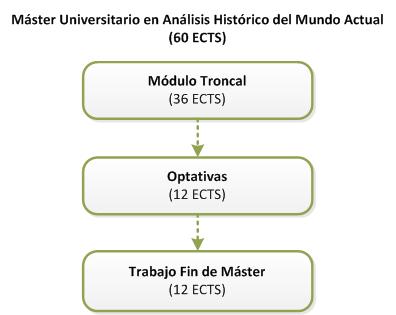Structure and distribution of credits
{{pre.error[0].message}}
{{pre.error[0].message}}
| Course | Basic | Mandatory | Optatives | Curricular internships | End of Studies Dissertation | Total |
|---|---|---|---|---|---|---|
| {{curso}}º | {{c.credects}} | {{c.credects}} | {{c.credects}} | {{c.credects}} | {{c.credects}} | {{creditos | map: 'credects' | toArray | sum}} |
| Total | {{ct.credects}} | {{ct.credects}} | {{ct.credects}} | {{ct.credects}} | {{ct.credects}} | {{cre.creditos_totales | map: 'credects' | toArray | sum}} |
The structure of contents and credit load is the following one:
MODULE 1: COMPULSORY STUDIES (36 credits: 6 compulsory subjects x 6 credits)
MODULO 2: ELECTIVE STUDIES (36 credits: 5 elective subjects x 6 credits, in addition to a 6 credits Face-to-Face Monographic Course, of which students must take 2).
MODULE 3: MASTER’S THESIS (12 credits)
The timing sequence of the Master's will be the following:
First Semester:
- Module 1 (Compulsory Studies): Subject I (Course 1) and Subject II (Subjects 2 and 3)
- Module 2 (Elective Studies): Subject IV (Subjects 7 and 8) and Subject V (Subject 10)
- Beginning the preparation of the Master’s Thesis.
Second Semester:
- Module 1 (Compulsory Studies): Subject III (Subjects 4, 5 and 6)
- Module 2 (Elective Studies): Subject V (Subjects 9 and 11) and Subject VI (Face-to-Face Monographic Course)
- Presentation of the Master’s Thesis
The academic structure of the “Master’s in Historical Analysis of the Present” intends to offer a wide, innovative and specialised point of view on the main historical processes developed in the contemporary era so that students may carry out a comprehensive and critical analysis on today’s world. In this sense, the Master’s structure comprises a series of basic compulsory contents, summarised in the Module 1 (Subjects I to III; Subjects 1-6), that include the study of methodological, historiographical, political, ideological, economic and social aspects.
In the second specialisation level, the Master's offers a collection of elective studies that will permit students to introduce in new aspects of the contemporary Historiography or specialising in specific subjects split from the previous module. This collection of elective subjects appear included in Module 2 (Subjects IV-VI; Subjects 7-12). Within this module, students must take two subjects. One of the elective subjects offered will correspond annually with a Face-to-Face Monographic Course offered by the International University of Andalusia, within the regular programming of some of its Campus. This free subject matter Course, which will be established annually and will be subject to the approval of the Academic Planning Committee of the UNIA, at the Master Academic Committee’s proposal, will allow to deal with innovative and contemporary discussions and research in the field of Contemporary History. The UNIA, in compliance wit its internal rules, will establish the minimum number of students enrolled for teaching this course. The rest of universities will undertake to recognise this Course as training subject, in accordance with the inter-university agreement.
The Master’s academic load is completed with the preparation and public defence (in person or by video conference) of the Master’s Thesis, which has 12 credits.
